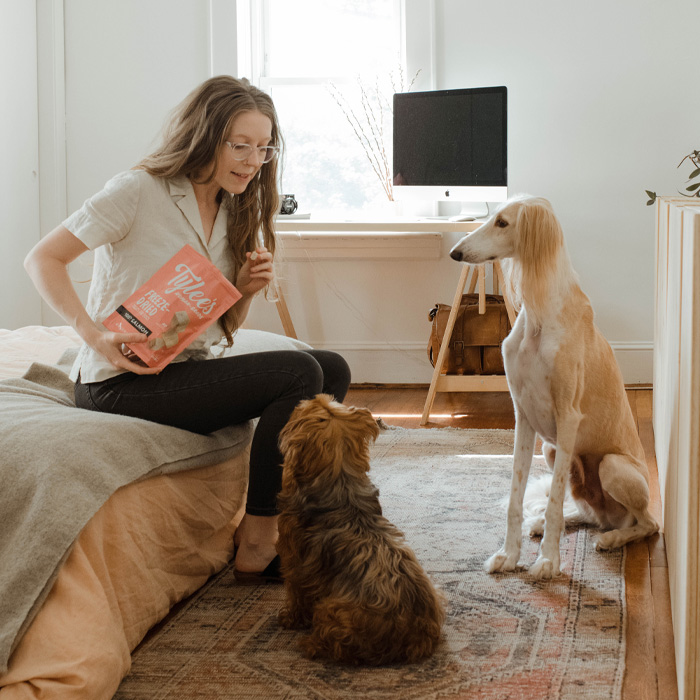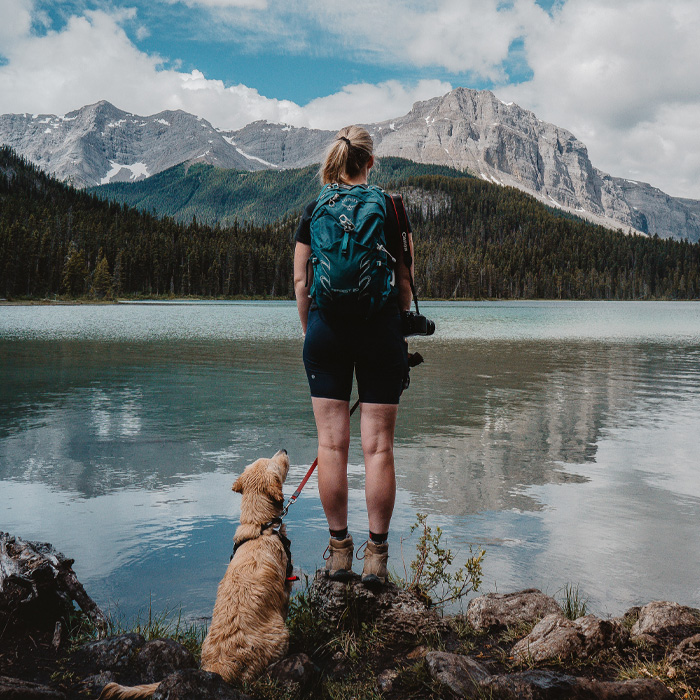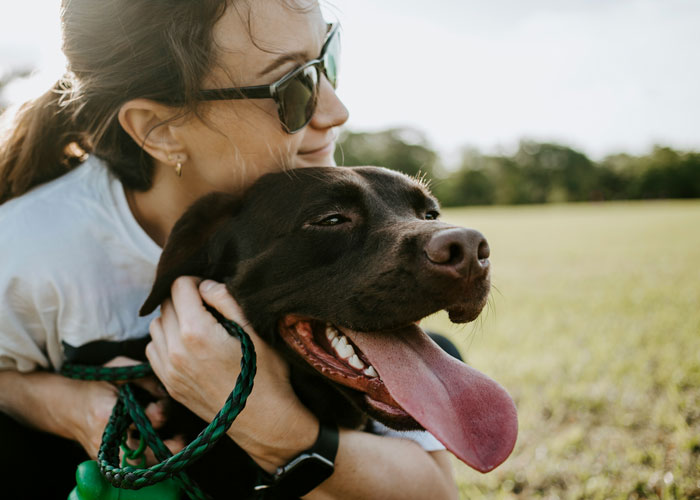Dogs are often lovingly referred to as man’s best friend. A relationship between a human and a dog can greatly add to both parties’ lives. But how does this special human-animal bond develop?
Whether you are trying to bond with a new dog you have just adopted or want to strengthen the bond with your existing canine companion, there are several strategies you should learn about. In this article, we will cover 9 effective ways to bond with your dog.
- Training fosters trust via positive reinforcement.
- Playtime is key for a close bond, ideally daily.
- Routine provides reliability, increasing trust.
- Physical affection is crucial for a strong bond.
- Giving space to your dog helps build confidence.
The information provided herein is for informational purposes only. Please refer to our disclaimer for more details..
1. Training and Positive Reinforcement
Image source: Chewy
Like humans, dogs should be considered lifelong learners. This means that regardless of your dog’s age and training level, all dogs can benefit from training. Training can also help strengthen your bond with your four-legged friend.
The inherent need for effective communication during training fosters obedience but perhaps more importantly, trust between you and your dog. This largely occurs through the positive reinforcement that comes with appropriate training. It should be stressed that training methods like punishment and negative reinforcement are unacceptable and detrimental to the human-animal bond.
2. Rewards and Praise That Fit Your Dog’s Preferences
Many people commonly think of treats or vocal praise as a common means of rewarding good behavior in their dog.
And while treats may be a useful training tool in food-motivated dogs, this is not the only way to encourage good behavior. For example, for dogs who love toys, offering your dog’s favorite toy to him after he has correctly obeyed a command can be an effective and fun way to teach a new trick.
As dog owners, we should also be aware that not every dog enjoys the same activities. There is a stereotype that all dogs love long walks or fetching a ball but that’s just not true.
Just like people with different love languages give and receive love in different ways, dogs have unique interests. Make the effort to observe what your dog enjoys doing the most and then spend intentional and quality time engaging in those activities with them.
3. Exercise With Your Dog
Image source: Devon Hawkins
Physical exercise is an important basic need for both dogs and humans alike. Exercising together is a great way to keep both you and your furry friend fit and healthy while building a stronger bond with your dog.
Before you rush to go run with your dog, remember that different dogs require and tolerate varying levels and intensities of physical activity. For example, a dog with orthopedic issues like arthritis may need lower-impact activities like short walks whereas a young sporting or agility dog may require something more strenuous like a hike.
4. Regular Playtime With Your Pup
Playtime is a fun and exciting way to engage with your dog. The key is to incorporate playtime regularly into your schedule. Ideally, you should play with your dog daily, even if it’s only for 10 to 15 minutes.
During this time, give your full attention and focus to your canine companion; yes, this means putting your phone away. While playing fetch is fun, you can also use puzzle toys, play hide and seek, or even run through the sprinklers. Play sessions are a wonderful opportunity for the whole family to get creative and build a stronger bond with your pet.
5. Routine and Consistent Communication
Image source: Wade Austin Ellis
Dogs are creatures of habit and thus, thrive on having a consistent routine. This means following a schedule when it comes to feeding times, walking, bathroom breaks, playtime, and bedtime. Having a routine is associated with a lower likelihood of behavioral problems in dogs as well as increased owner satisfaction. By implementing a predictable routine, you provide reliability and help build trust with your dog.
Additionally, dogs benefit from consistent rules and communication. Dogs want to please their owners but to do this, they need to know what you expect from them.
You can communicate more clearly with your dog by using specific verbal cues. Remember, non-verbal communication is important too; dogs pick up on your energy, emotions, and body language so try to stay calm and positive.
6. Physical Affection
Physical contact in the form of petting or cuddle time is a quintessential part of forming a strong bond with your dog. Whether you have a lap dog who loves to snuggle or a more independent pooch, taking time to physically connect through touch is crucial in establishing and maintaining a close bond.
Take note of where your dog likes to be pet; some dogs crave belly rubs while other dogs are more comfortable with a simple scratch behind the ears. In addition to snuggling, you can also provide physical affection by giving your dog a gentle massage or brushing her if she enjoys being groomed.
7. Familiarize Yourself With Canine Body Language
image needed
Even though dogs can’t communicate with us through words, they tell us a lot through their body language; we just have to pay attention. By learning about dogs’ body language, we can better understand our dog’s thoughts and feelings. Getting acquainted with canine body language helps break down the language barrier and makes it easier for you to strengthen your relationship with your dog.
8. Give Treats But Maintain a Balanced Nutritional Diet
Many pet parents equate food with love. But we have to be careful when it comes to using food or treats as a means of showing affection to our dog. Occasional treats are okay but they need to be factored into your dog’s recommended daily caloric intake.
Monitoring how much your dog eats is essential because over 50% of dogs are overweight or obese., which can lead to or exacerbate other health conditions. In addition to managing the amount of food and treats your dog eats, it is also important to pay attention to the quality of food and treats you’re choosing. Consult your veterinarian for more guidance about weight management and how to provide balanced nutrition for your dog.
9. Give Your Dog Space
Finally, allow your dog space. This may seem counterintuitive when it comes to bonding with your dog but it’s actually an important way to build trust.
Giving your dog space will also help him become more confident. Dogs are den animals and thus, should have their own safe space such as a crate or a dog bed in a quiet area. Having an easily accessible place to rest and relax on their own gives dogs a sense of safety when they need a break.
FAQs
How Long Does It Take To Form a Bond With Your Dog?
Dogs can start to become comfortable with their owner in a few days but it takes much longer to form a true bond. Every dog is different but it can take anywhere between several weeks to several months to build a strong bond with your dog.
This variability is largely dependent on your dog’s history. For example, a dog who has suffered previous trauma or abuse may take longer to trust you.
How Do Dogs Choose Who They Bond With?
In general, dogs bond most closely with whoever gives them the most positive attention. This includes walking, feeding, training, cuddling, and more. Ultimately, dogs bond with whoever is in charge of meeting their basic needs and the person who spends the most quality time with them.
How Do You Tell if Your Dog Is Happy Living With You?
Happiness in dogs can manifest in a variety of ways. One of these is body language, which can include tail wagging, soft eyes, relaxed body posture, and neutral ear position. A happy dog should also have a good appetite and should not be exhibiting destructive behavior (e.g. chewing on things he shouldn’t). Overall, a dog who is happy living with you should be comfortable and relaxed but still playful at times.
766views
Share on Facebook
 Dark Mode
Dark Mode 

 No fees, cancel anytime
No fees, cancel anytime 





















































6
0